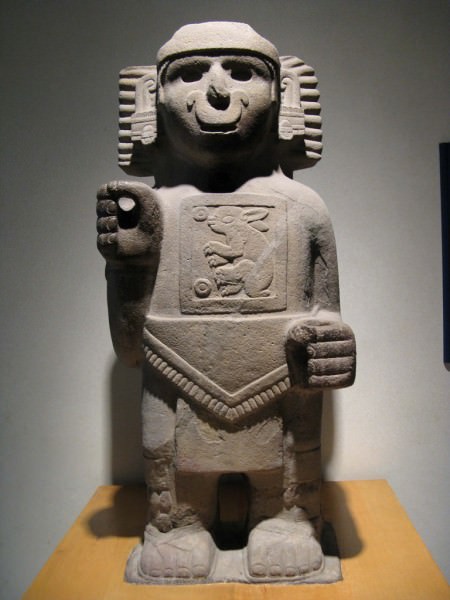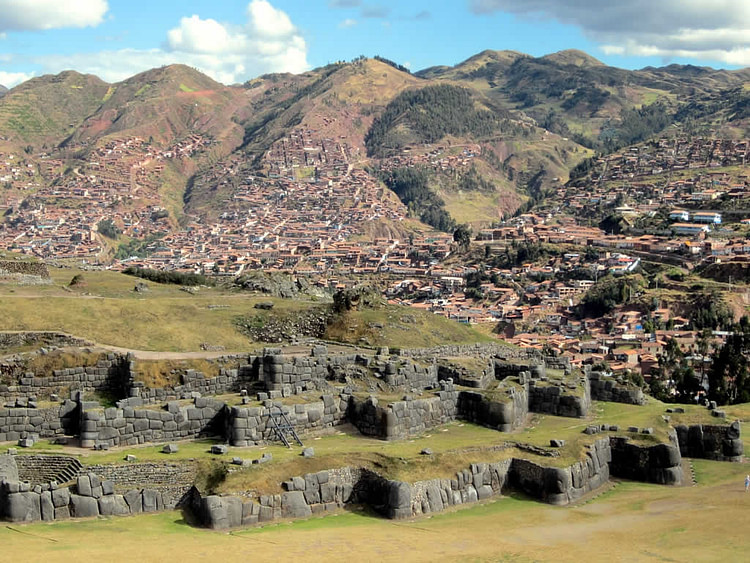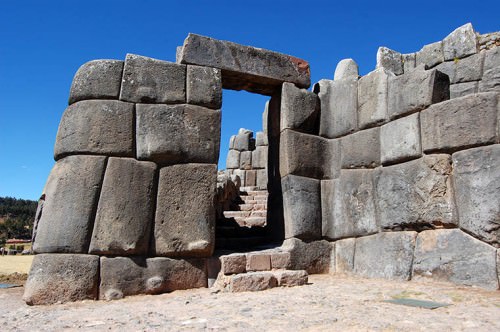Pulque › Sacsayhuaman » Ancient origins
Articles and Definitions › Contents
- Pulque › Ancient History
- Sacsayhuaman › Antique Origins
Ancient civilizations › Historical and archaeological sites
Pulque › Ancient History
Definition and Origins

Pulque is an alcoholic drink which was first drunk by the Maya, Aztecs, Huastecs and other cultures in ancient Mesoamerica.Similar to beer, it is made from the fermented juice or sap of the maguey plant ( Agave americana ). In the Aztec language Nahuatl it was known as octli and to the Maya it was chih. Only mildly alcoholic, the potency of pulque was often increased with the addition of certain roots and herbs.
The drink had its own personified goddess and was featured in episodes of Mesoamerican mythology. Drunk in moderation throughout the region on a daily basis it was served in more copious amounts at important religious festivals and celebrations such as weddings, fertility rites (especially those involving the Aztec god of Summer Xochipilli ), and agricultural ceremonies.The substance was not just drunk as the Huastec used pulque as an enema using thin hollow bones; this was a relatively common practice in the administration of hallucinogens in the ancient Americas.
PULQUE IN MYTHOLOGY - MAYAHUEL
The maguey plant, important not just for pulque but also as a source of fibres for weaving, had its own personified deity – a goddess known as 11 Serpent by the Post-classic Mixtecs. In central Mexico the goddess was known as Mayahuel and usually depicted as a beautiful young woman. She was associated with fertility and sometimes referred to as 'the woman of 400 breasts' no doubt in reference to the milk-like sap of the plant. Pulque was also personified as a goddess known as 2 Flower.In addition, the god 3 Alligator was closely associated with the drink.
TO BRIGHTEN UP THEIR LIVES QUETZALCOATL DECIDED TO GIVE HUMANITY A DRINK WHICH WOULD LIFT THEIR SPIRITS.
The consumption of pulque, then, went right back into mythological times and there was, naturally, a myth to explain its invention. The great god Quetzalcoatl was watching humanity one day and noticed that at the end of the working day the people did not dance and sing but, instead, seemed rather miserable. To brighten up their lives Quetzalcoatl decided to give them something which would lift their spirits. Falling in love with a beautiful goddess Mayahuel, Quetzalcoatl whisked her off to Mesoamerica and there, embraced, they turned into a tree with two branches. Now, Mayahuel's grandmother was not best pleased with this turn of events and so, accompanied by a troop of fellow demons ( tzitzimime ), she attacked the tree, splitting it into two. Mayahuel was then ripped to pieces and eaten by the terrible demons. A heartbroken Quetzalcoatl collected the bits and pieces left of his lover and tenderly buried them. Eventually, these remains grew into the first maguey plant and humans used it to make pulque. In the end, Quetzalcoatl's wish that humanity might benefit from a drink which increased their happiness came to pass.
Another famous myth is when Quetzalcoatl, under the drink's influence, slept with his sister, Quetzalpetlatl. The god's realization and embarrassment on discovering his shameful act the next morning was used as an explanation as to why the god abandoned Tula, his capital. The episode was also a warning to the Mesoamericans that abuse of pulque could carry serious consequences. For this reason the Aztecs were rather more particular about who could drink pulque compared to other Mesoamerican cultures. They reserved its consumption in public as a special privilege for nobles and warriors and imposed penalties ranging from head-shaving, property destruction, and even the death penalty for repeated cases of drunkenness.
THE 400 PULQUE GODS
There was also a group known as the pulque gods who were almost always males. These were particularly important to the Aztecs who called them the Centzon Totochtin (400 Rabbits) as it was believed a rabbit had first discovered the juice of the maguey by nibbling on a leaf. The mother of the pulque gods was Mayahuel and their father Patecatl. Taking on many forms, their exact significance has been difficult to determine. Many were associated with specific towns, days, and time periods.They were also representative of drunkenness and sexual lust and so wore half-moon nose rings, symbol of Tlazolteotl, the goddess of lust and filth.

Mesoamerican God 2 Rabbit
As a group the pulque gods were represented as either the god Ome Tochtli or 2 Rabbit. Several pulque gods have been identified as ceremonially buried beneath the Templo Mayor temple at Tenochtitlan, the Aztec capital. Historian Mary Miller suggests this was in homage to the 400 victims killed by the god Huitzilopochtli in Aztec mythology.
REPRESENTATIONS IN ART
The earliest depictions in Mesoamerican art of pulque are from the great city of Teotihuacan, at its peak between 300 and 550 CE. Here stone relief carvings show masked figures with milky drops falling from their mouths and one mask has a background of maguey leaves.
Monuments set up by the Zapotec civilization (500-900 CE) show scenes from wedding ceremonies where guests are drinking pulque. From the Post-classic period (900-1200 CE) there is a rock painting at Ixtapantongo which is the earliest representation of Mayahuel. She is shown within a maguey plant and holding a cup in each hand, probably containing pulque.
As pulque had a milk-like appearance it was associated with mother's milk and this is evidenced in such artefacts as the Aztec Bilimek Pulque Vessel on which is a scene showing the drink pouring from the breast of an earth goddess. Finally, Mayahuel and the pulque gods appear in illustrations in several colonial-era codices, notably the Mixtec Codex Vindobonensis (sheet no. 25) and on several sheets in the 16th century CE Aztec Codex Magliabechiano.
Sacsayhuaman › Antique Origins
Definition and Origins

The Sacsayhuaman (also Saksaywaman or Saqsawaman, meaning 'Royal Eagle') fortress- temple complex lies at the northern edge of the former Inca capital Cuzco. Constructed during the reign of Pachacuti (1438-1471 CE) and his successors, its massive, well-built walls remain today as a testimony not only to Inca power but also the skills of Inca architects and their approach of blending their monumental structures harmoniously into the natural landscape. The Sacsayhuaman is still used today for reenactments of Inca-inspired ceremonies.
CONSTRUCTION
The fortress was the largest structure built by the Incas. It was constructed on an elevated rocky promontory facing the northern marshy ground outside the Inca capital of Cuzco. Pottery finds indicate that the site had previously been occupied by Inca residents. Begun in the reign of the great Inca empire builder Pachacuti Inca Yupanqui, or perhaps his son Thupa Inca Yupanqui in the mid-15th century CE, the design was credited to four architects: Huallpa Rimachi, Maricanchi, Acahuana, and Calla Cunchui. The first structures were made using only mud and clay. Subsequent rulers then replaced these with magnificent stonework which employed huge finely-cut polygonal blocks, many over 4 metres in height and weighing over 100 tons. To complete such a massive project 20,000 labourers were drafted in under the well-established Inca system of extracting both goods and labour from peoples they conquered. Working in a system of rotation 6,000 were given quarrying duties while the other 4,000 dug trenches and laid the foundations. The walls of the fortress were built in vertical sections, probably, each section being the responsibility of one ethnic labour group.
The Incas were master stonemasons. Huge blocks were quarried and shaped using nothing more than harder stones and bronze tools. Marks on the stone blocks indicate that they were mostly pounded into shape rather than cut. Blocks were moved using ropes, logs, poles, levers, and earthen ramps (telltale marks can still be seen on some blocks), and some stones still have nodes protruding from them or indentations which were used to help workers grip the stone. That rocks were roughly hewn in the quarries and then worked on again at their final destination is clearly indicated by unfinished examples left at quarries and on various routes to building sites. The fine cutting and setting of the blocks on site was so precise that mortar was not necessary. Finally, a finished surface was provided using grinding stones and sand.
THE FORTRESS COMPLEX INCLUDED TEMPLES, NOTABLY ONE TO THE SUN GOD INTI, & WAS USED AS A LOCATION FOR INCA CEREMONIES.
Experimental archaeology has demonstrated that it was much quicker than scholars had previously thought to prepare and dress the stones used by the Incas. Even so, it would have taken many months to produce a single wall. The Incas also ensured that their blocks interlocked and the walls were sloped to maximise their resistance to earthquake damage. Time has proved their efficiency as 500 years of earthquakes have done remarkably little damage to Inca structures left in their complete state and the Sacsayhuaman is no exception.
DESIGN
If the theory that all of Cuzco was laid out to form a puma shape when seen from above is correct, then Sacsayhuaman was its head. The fortress has three distinct terraces which recede backwards on each other. The walls, each reaching a height of 18 metres, are laid out in a zigzag fashion stretching over 540 metres so that each wall has up to 40 segments, which allowed the defenders to catch attackers in a crossfire; a result helped also by the general curvature of the entire fortress facade. In addition, Inca architects very often sought to harmoniously blend their structures into the surrounding natural landscape and the outline of the Sacsayhuaman was similarly built to mimic the contours of the mountain range which towers behind it. This is particularly evident when the sun creates deep triangular shadows between the zigzag terraces in exactly the same way that it does on the mountain range with its peaks and valleys.

Sacsayhuaman
In another defensive consideration, there is only one small doorway on each terrace which gave access to the interior buildings and towers on the hillside behind. Eyewitness Spanish accounts describe a large circular four or five-storey tower centrally placed within the fortress and its foundations (along with those for two others) can be seen today. To the rear of the complex, in an area known as the Suchuna (slide), there were more terraces, patios, outbuildings, and a system of water supply including cisterns and aqueducts. Finally, there is an area of stepped terracing cut into the side of the Rodadero Hill, which is thought to have been a religious shrine, perhaps dedicated to the earth goddess Pachamama, or a viewing platform for the Inca ruler to watch ceremonies from or a place for astronomical observations.
FUNCTION
On completion, the fortress was said to have had a capacity for at least 1,000 warriors, but it was rarely needed as the Incas did not suffer invasions from enemy states. Probably, for this reason, Sacsayhuaman was designed as much more than a fortress. The complex included temples, notably one to the sun god Inti, and was used as a location for Inca ceremonies. The Sacsayhuaman was also a major Inca storage depot where arms, armour, foodstuffs, valuable textiles, ceramics, metal tools, and precious metals were kept.

Sacsayhuaman Terrace Gateway
The Sacsayhuaman did operate as a fortress during the Spanish conquest of Peru from 1532 CE. The Spaniards, led by Francisco Pizarro, conquered Cuzco shortly after killing the Inca ruler Atahualpa in 1533 CE but then faced an organised and sustained siege from a large Inca army. Pizarro sent his brother Juan to attack the Sacsayhuaman using cavalry and then climb the walls with ladders. The offensive was successful, even if Juan died in the process, and the occupation of the fortress allowed the Spanish to resist the siege.
LATER USE
Following the collapse of the empire after the European invasion, most of the stones of the Sacsayhuaman were reused elsewhere in the colonial buildings of Cuzco. The ruins were covered in earth by the Spanish to prevent their use by rebel Inca forces and the site was not rediscovered until its excavation in 1934 CE. Today the ruins of the fortress are the location for the annual Inca reenactment festival the Inti Raymi, held on the winter solstice.
MAP
LICENSE:
Article based on information obtained from these sources:with permission from the Website Ancient History Encyclopedia
Content is available under License Creative Commons: Attribution-NonCommercial-ShareAlike 3.0 Unported. CC-BY-NC-SA License